Understanding your customers’ true feelings about your brand is more crucial than ever. Enter the Net Promoter Score (NPS) – a straightforward yet powerful metric that reveals how likely your customers are to recommend your business.
But NPS is more than just a number; it’s a window into customer satisfaction and loyalty, offering valuable insights that can drive your business decisions.
In this quick guide, we’ll break down everything you need to know about NPS, from its basics to actionable strategies to boost your score and elevate your brand’s customer experience.
What Is Net Promoter Score?
Developed by Fred Reichheld, Bain & Company, and Satmetrix in 2003, the Net Promoter Score (NPS) is a metric that helps you measure customer loyalty and satisfaction with your company, product, or service.
It provides insight into customers’ likelihood to recommend a brand to others.
To calculate NPS, companies typically ask customers a single question: “On a scale of 0 to 10, how likely are you to recommend our company/product/service to a friend or colleague?”
Based on their response, you can classify customers into three categories:
- Promoters (score 9-10): These are highly satisfied and loyal customers who will likely recommend the brand to others. They contribute to positive word-of-mouth and help drive business growth.
- Passives (score 7-8): These customers are somewhat satisfied but not enthusiastic about the brand. They may be vulnerable to competitive offers and not actively promote the brand.
- Detractors (score 0-6): These unhappy customers are unlikely to recommend the brand. Detractors can harm the company’s reputation through negative word-of-mouth and may churn to competitors.
How to calculate net promoter score?
To calculate the Net promoter score, you’ll have to subtract the percentage of detractors from the percentage of promoters.
NPS = % Promoters – % Detractors
Let’s see it in action:
For example, if 60% of respondents are promoters, 20% are passives, and 20% are detractors, the NPS would be:
NPS = 60% – 20% = 40
What do these numbers indicate?
The resulting NPS can range from -100 to +100, representing customers’ overall sentiment.
A positive NPS indicates more promoters than detractors, suggesting a favorable customer perception.
On the other hand, a negative NPS indicates more detractors than promoters, signaling areas for improvement.
Why Is Net Promoter Score Important?
NPS is one of the most critical metrics for any business that measures the customer experience.
Since the customer experience drives revenue and growth for any business, it’s essential that companies understand how their customers feel about them.
This makes NPS a key performance indicator (KPI) that can help you drive growth.
Here are some more benefits of NPS when used as a KPI for an ecommerce business:
- Measuring Customer Loyalty: NPS allows e-commerce businesses to assess customer loyalty by measuring the likelihood of customers recommending their brand to others.
- Identifying Brand Perception: By segmenting respondents based on their NPS scores, e-commerce businesses can understand how customers perceive their products, services, and overall brand experience.
- Word-of-Mouth Marketing Potential: Satisfied customers who act as promoters not only contribute to increased sales but also serve as brand ambassadors, generating positive word-of-mouth marketing.
- Helps Improve Customer Experience: NPS helps identify areas of improvement within the e-commerce customer experience. By analyzing the feedback and comments provided by detractors and passives, businesses gain actionable insights into the pain points and shortcomings of their offerings. These insights can guide decision-making processes, leading to targeted improvements in website design, product assortment, customer support, or shipping and delivery processes.
- Benchmarking and Comparison: By tracking NPS over time, businesses can evaluate the impact of their initiatives and measure their progress in meeting customer satisfaction goals.
The limitations of NPS
In theory, NPS is a great way to benchmark your customer service and find areas where you can improve. In practice, however, there are some limitations to this metric that you should be aware of before using it as part of your business strategy.
Here are some key limitations of NPS:
- Simplified Measurement: By reducing complex customer sentiments to a single score, NPS may overlook important nuances and fail to capture the full spectrum of customer experiences.
- Lack of Context: NPS alone may not provide sufficient context to understand the reasons behind customers’ scores. While the score indicates whether customers are promoters, passives, or detractors, it does not reveal the underlying factors driving their responses. However, you can supplement NPS with open-ended feedback or follow-up surveys to gain deeper insights.
- It only measures one aspect of customer satisfaction: NPS only measures how likely someone is to recommend a brand or product to others – not whether they’d actually do so in practice. This means it can’t tell if they’re actually satisfied with their purchase or not (which is arguably more important).
- Limited Differentiation: A customer giving a score of 7 might have different intentions and feelings compared to a customer giving a score of 6. The lack of granularity in NPS can result in a loss of valuable insights, making it challenging to differentiate between customers with varying degrees of loyalty or satisfaction.
- Limited Predictive Power: While NPS provides a snapshot of customer loyalty and advocacy, it does not necessarily predict future behaviors. For example, there’s no way of knowing whether a customer intends to purchase again. To understand customer behavior comprehensively, complement NPS with other metrics, including customer retention rates, conversion rates, or referral tracking.
Best Practices for Running Net Promoter Score Surveys
1. Keep the survey short and simple:
The best NPS surveys are short, simple, and easy to complete. They should not ask too many questions or make participants work too hard to answer them.
The goal of the NPS survey – or any survey, for that matter, is to get customer feedback, but it’s not always easy to get people to take the time to fill one out. If you overload your survey with questions or ask for too much information, you may get fewer responses than you’d like – or none at all.
Here’s a good example of a short and simple NPS survey from Slack, a business messaging app.

This doesn’t mean you should make your NPS survey as short as possible by cutting out every question. The key is to find the right balance between asking enough questions to get useful feedback and not asking so many questions that respondents won’t have time or interest in finishing it.
2. Ensure clarity in your NPS survey question
It can be tempting to ask your customers more than they’re willing to answer. And sometimes businesses even find it difficult to frame the right question.
However, it’s essential to craft your survey question in such a way that customers understand precisely what they’re being asked.
If you ask a vague question in your NPS survey, you’ll get a vague answer – and it won’t be very helpful. This is especially true if you ask multiple questions in one go or ask something that requires a lot of thought (or both).
You have to give people enough context so they can provide an informed response.
For example, “How likely are you to recommend our services?” doesn’t tell respondents anything about what they should be thinking about when answering this question. A better way to phrase this might be: “How likely are you to recommend our services on Facebook?”
3. Include an open-ended follow-up question
NPS surveys are great for measuring customer satisfaction but don’t tell you much about why customers are satisfied or dissatisfied.
It would help if you dug deeper to understand what factors drive your NPS score. To this end, you can add an open-ended follow-up question to complement your NPS survey.
For example: “How likely are you to recommend us to a friend or colleague?” [0-10 scale]
If you want to learn more about what drives the response, ask them: “Please tell us more about why you gave us a score of X.”
Have a look at this open-ended NPS survey follow-up question, for instance:

4. Optimize survey distribution channels
NPS surveys are a great way to measure customer satisfaction and loyalty. But you can’t just send them out willy-nilly and expect everyone to respond.
Your NPS survey distribution channels need to be optimized for the best results.
For starters, utilize email as a primary distribution channel, especially if you have an existing customer database.
Personalize the survey invitations, including the customer’s name and any relevant information about their interactions with your business. At the same time, your email should be visually appealing and mobile-friendly to cater to different devices.
Here’s an excellent example of an NPS survey sent via email:
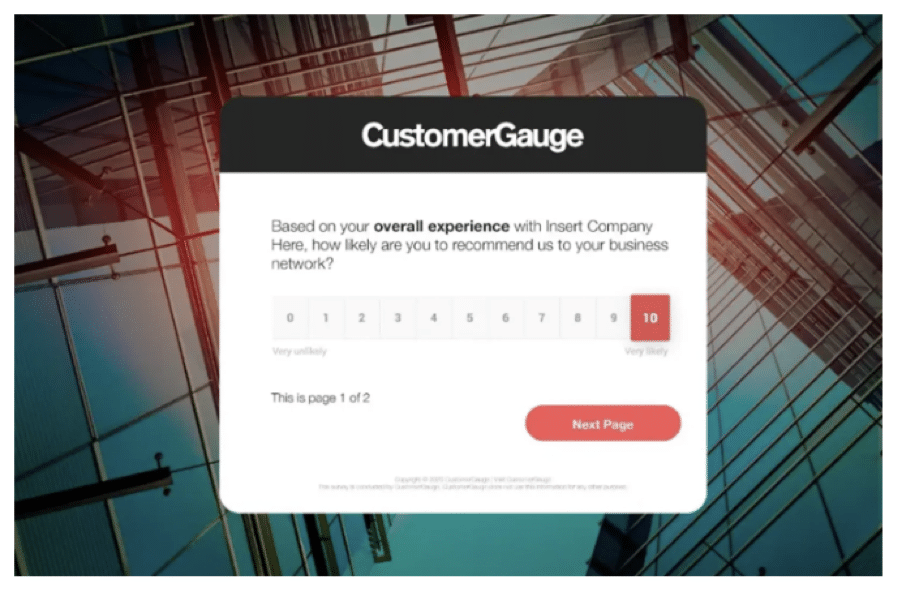
Another distribution channel is your own website or in-app pop-ups. You can capitalize on your website or application’s existing traffic by presenting NPS survey pop-ups at strategic touchpoints.
Consider timing the pop-ups based on user behavior, such as after completing a transaction or when visiting a specific page.
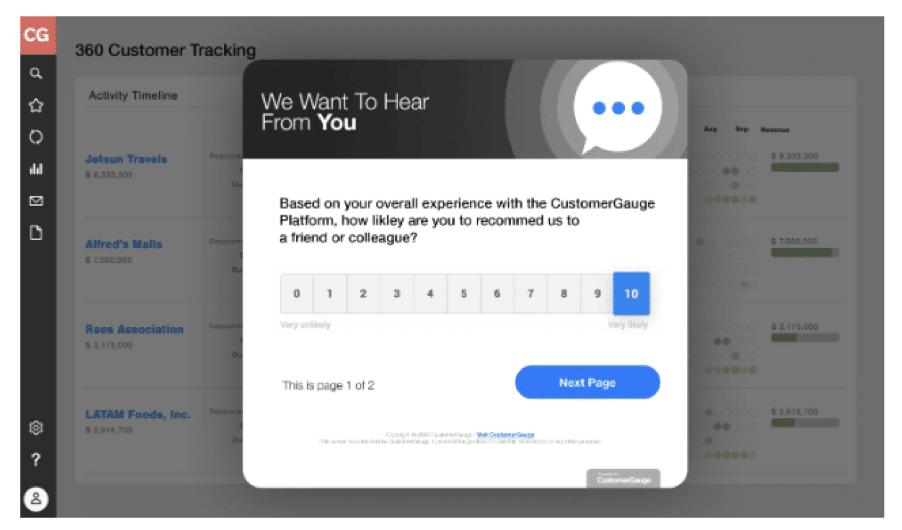
Additionally, you can use social media as part of your NPS survey distribution strategy by posting links in relevant groups or communities. You can also use hashtags and tag influencers to gain even more exposure for your survey.
5. Personalize survey invitations
When you send a Net Promoter Score (NPS) survey invitation, it’s important to personalize it to make your recipients feel like they’re part of an exclusive group.
Here are some tips:
- Make sure your email subject line is personalized.
- Use a custom sender address, like “Dear John” or “Hi Jane.”
- Include a personalized message in the email body and even mention something about them by name.
- If you’re sending an email to multiple people, it’s especially important to include their names in the body copy so they know who it’s from.
- Use a friendly greeting and a survey invitation that speaks to your customer’s needs, not yours.
6. Offer incentives
When someone takes the time to respond to your survey invitation, show them how much you appreciate their feedback by offering an incentive for taking part in the survey.
It doesn’t have to be something big – maybe just some coupons or free shipping on their next purchase.
Here are some ideas:
- Monetary incentives: Consider offering a small discount, coupon, or gift card as a token of appreciation for completing the survey. This can be particularly effective when targeting customers who have recently made a purchase or had a significant interaction with your business.
For instance, Pizza Pizza offers a monetary reward in the form of a voucher that clients can use on their next purchase.
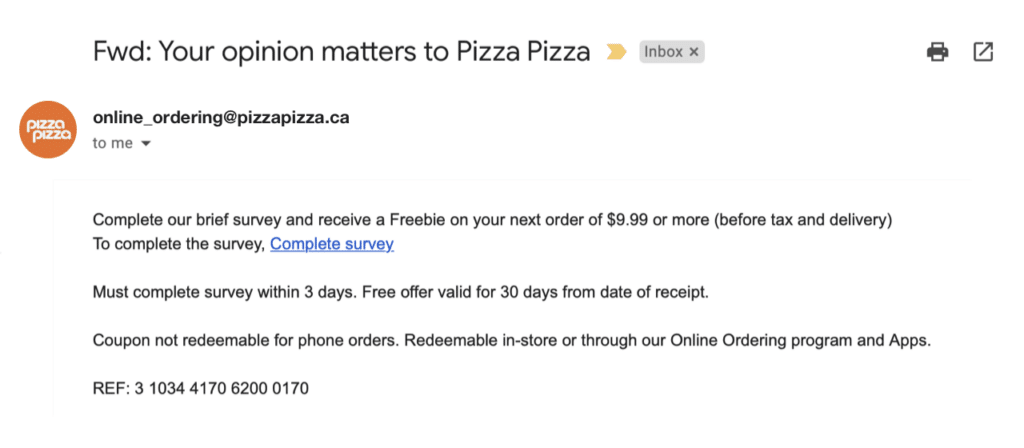
- Exclusive content or early access: Provide survey participants with access to exclusive content, sneak peeks of upcoming products, or early access to promotions or events. For example, you could provide NPS survey respondents exclusive access to a new feature or beta version of a product before its official release.
- Loyalty program rewards: If your business has a loyalty program, offer additional rewards or loyalty points for completing the NPS survey.
- Social recognition: In these days of social media, you can publicly acknowledge and appreciate survey participants through social media shout-outs, testimonials, or featuring their feedback on your website.
Whatever your incentive is, it should be relevant to your audience to encourage more people to participate and give you better insight into what they think about your brand overall.
Strategies for increasing Net Promoter Scores and customer satisfaction
Now that we have learned how to make the most out of your NPS surveys, it’s time to see how to elevate your results. What can an ecommerce business do to impress its customers and increase its NPS scores?
Let’s find out:
1. Improve product or service quality
Improving product or service quality can have a significant impact on your Net Promoter Score (NPS). In fact, improving quality has one of the highest correlations with NPS, which is why most companies focus on it.
Quality is a broad concept, and there are many ways to define it.
For example, you can define it as the quality of the product or service itself, the quality of the customer experience, or even the quality of your relationship with customers.
However you choose to measure quality, keep in mind that it can be affected by several factors:
- Customer satisfaction with products and services. Quality improves as customer satisfaction increases — if people are happy with what they get from you, they’ll tell other people about it.
- Customer loyalty. You need happy customers to stay loyal, so improving their experience will help keep them around longer and reduce churn rates.
- The ability to meet customer expectations — both implied and explicit — is critical for building trust between brand and consumer. For example, if customers expect something but don’t get it when they make a purchase or use your service, then there will be negative repercussions such as refunds or bad reviews online.
2. Enhance the customer experience
The customer experience is the most important factor for businesses to focus on.
In fact, a study predicted that customer experience will surpass price and product as the key brand differentiator.
And it’s not just about the quality of your product; it’s about how your customers feel about you and your business.
Here are some tips for enhancing customer experience:
- Use surveys to improve the customer experience.
- Provide consistent service across channels, including social media and live chat.
- Use predictive analysis to identify problems before they happen.
- Collect customer’s data to personalize recommendations based on their preferences, address them by name in your marketing campaigns, and cater to their specific needs and preferences.
3. Actively seek and act upon customer feedback
Actively seeking customer feedback has a number of benefits:
- It can help identify problems with your product or service faster than you would otherwise.
- You can uncover opportunities to improve your customer experience before your competitors do so.
- It leads to increased customer retention by improving the way you support your customers after purchase, helping them achieve their goals with your product or service, and preventing them from switching to a competitor’s offering.
- It can help you improve employee performance by providing clear guidance on how to deliver outstanding service and by allowing employees to learn from the successes and failures of others in the organization (which they wouldn’t get if they only saw their own performance metrics).
To get optimum results, various channels should be implemented to collect customer feedback, including surveys, feedback forms, online reviews, social media listening, and customer support interactions.
Once you gather user feedback, prioritize the identified areas for improvement based on their impact on customer experience and business goals. Determine which aspects need immediate attention and create an action plan to address them effectively.
For instance, Uber uses a real-time rating system to collect customer feedback and correct issues.
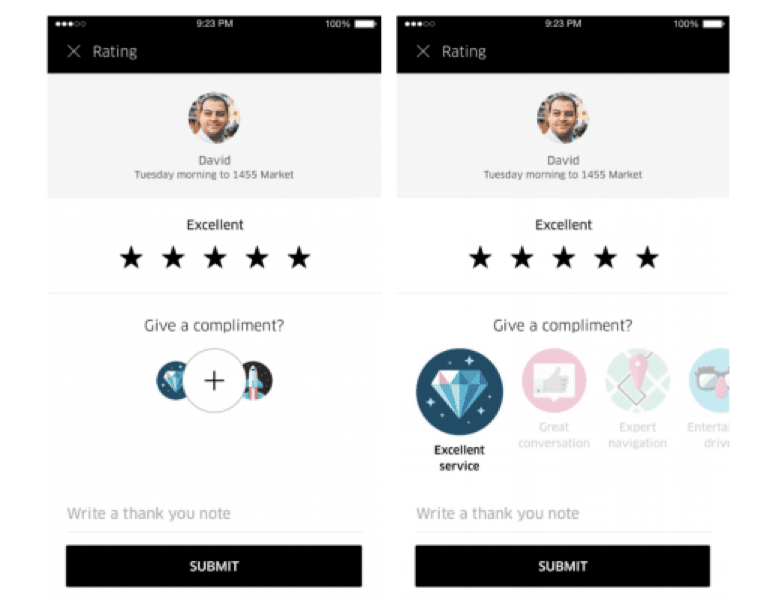
It ensures that only the best drivers stay on the road, leading to better customer satisfaction.
4. Reward and recognize loyal customers
The more satisfied your customers are, the better your NPS score will be.
And one of the most important aspects of satisfying customers is implementing reward and recognition programs to acknowledge loyal customers.
By acknowledging and appreciating customers for their support and advocacy, you can also motivate them to continue promoting the brand.
But how do you go about it? Here are some tips:
- Run loyalty programs: Implement a loyalty program to reward your recurring customers. You can offer exclusive discounts, special offers, early access to products or services, or tiered benefits based on customer loyalty levels.
Referral programs: Encourage your existing customers to refer your brand to their friends, family, or colleagues to your business. Make sure you’re rewarding both the referrer and the referred customer to win over both of them.
For instance, H&R Block Canada re-launched its “Refer a Friend” campaign to reward loyal customers who refer friends via an automated email system.
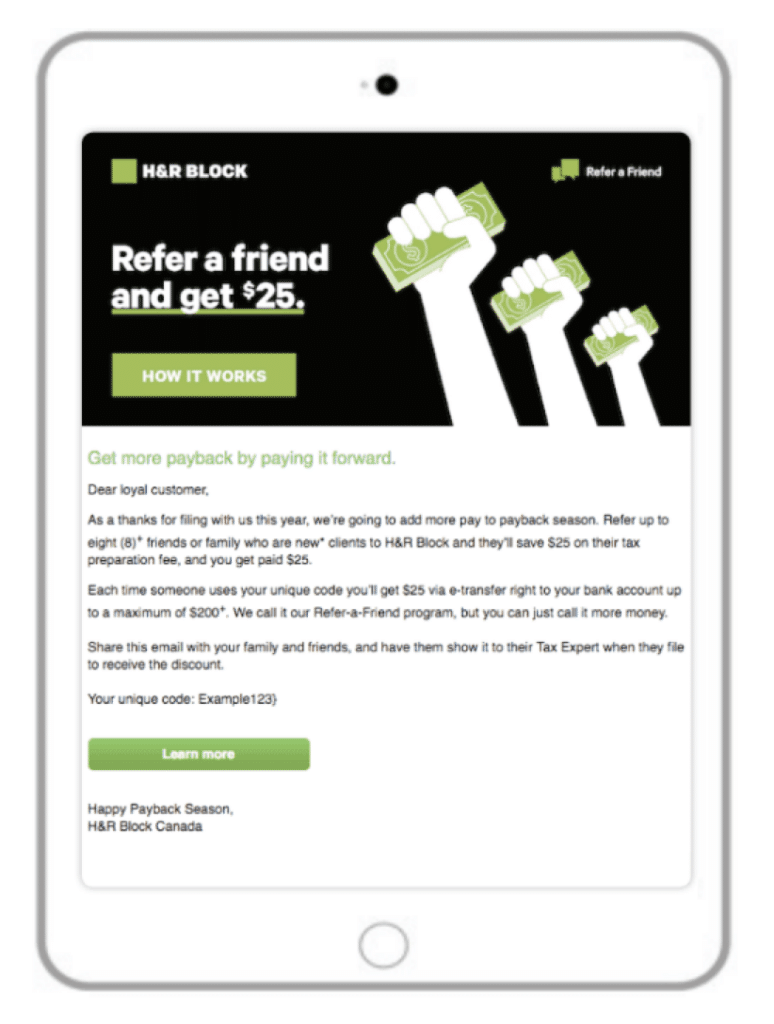
- Customer appreciation events: Host exclusive events or experiences that appreciate and acknowledge loyal customers. These events can include product launches, networking opportunities, or workshops tailored to their interests.
5. Establish clear and transparent communication
If you’re looking to increase your NPS scores, it’s important to establish clear and transparent communication with your customers. This means being able to answer their questions quickly and accurately, no matter how small the issue.
When a customer contacts you with a question or concern, it’s important that you respond in a timely manner. If your business has an email address for customer service inquiries, make sure this email isn’t going into a spam folder. If it is, set up a separate account just for customer service emails so they will always land in your inbox.
You should also ensure that important information is easily accessible on your website. For example, if someone is looking for help with their account but can’t find their login information anywhere on the site, they might think twice about contacting customer support again.
6. Continuously innovate and adapt
It’s important to continuously innovate and adapt your product or service offerings to continue meeting customer expectations.
This will make customers happier, which will increase their likelihood of recommending you – and, in turn, improve your NPS score over time.
Take note: we’re not talking about annual upgrades or cosmetic changes – real innovation means changing your product or service offerings in ways that customers will notice and appreciate.
That’s a Wrap!
Understanding and effectively utilizing Net Promoter Score (NPS) can give your ecommerce business valuable insights into customer loyalty, satisfaction, and brand advocacy.
Focusing on strategies to increase NPS scores and customer satisfaction can drive growth, enhance competitive advantage, and build long-term customer relationships.
Key strategies include optimizing the customer experience, actively seeking and acting upon customer feedback, and implementing reward and recognition programs. Businesses can improve survey response rates and gather accurate feedback by prioritizing clarity in survey questions, optimizing distribution channels, and offering incentives. Analyzing feedback, prioritizing improvements, and communicating changes demonstrate a commitment to enhancing the customer experience and closing the feedback loop.
As the e-commerce landscape continues to evolve, businesses that invest in understanding and leveraging the power of NPS will be better equipped to meet customer expectations, deliver exceptional experiences, and thrive in a competitive market. By consistently monitoring and improving NPS scores, e-commerce businesses can build a loyal customer base, drive growth, and maintain a strong brand reputation.



